When it really comes down to it, HR is really the fine art of making comparisons – about HR professionals seeing where they and their organization stand – and how they compare to others – on things like their own HR budgets, pay; benefits, holiday entitlement; healthcare, and even metrics like gender pay gaps, female representation on the board, and rankings of maturity of digital transformation and happiness.
But it’s not always easy determining exactly where you stand.
So with 2024 only a few week old, and CHROs getting back into the groove, TLNT – in partnership with Lattice – thought it would be a good idea to share the sorts of data we think is essential to help you pin-point where you are when it comes to seeing how HR stands in organizations; what the priorities are of your peers; where firms are with things like AI and HR technology; and where things like DEIB stand in the grand scheme of things.
The data comes from Lattice’s ‘State of People Strategy Report – 2024’ – the full details of which can be read here in greater detail.
But we’ve done much of hard work for you, by summarizing some of its key observations it finds that allow you to benchmark your own progress:
Where to start… times are tough:
It’s tough out there! According to the report, 44% of HR leaders surveyed said they feel increased pressure from the C-suite to justify the investment in people programs.

Increased scrutiny, it claims, is being complicated by two factors: CHROs own strength of belief in the connection between their work and business outcomes, as well as them feeling confident in their own ability to demonstrate this to other stakeholders.
The good news is that by far the biggest area CHROs think they have the greatest impact is around productivity.
Some 83% of CHROs believe this.
But their confidence in their ability to impact other areas though is significantly lower. Only 60% feel able to demonstrate their impact in reducing costs, while fewer still doubt their ability to impact customer satisfaction (54%) and revenue (53%).
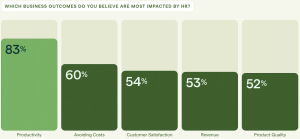
Worse still, is that outside of HR departments, the C-suite perspective of HR’s impact as even less.
For if HR teams need to demonstrate their connection to stakeholders, the data shows they’re struggling with this objective.
Only 27% of respondents said their C-suite sees a connection between HR programs and revenue growth.
Just 28% said their executive team sees a link to product/service quality and 30% to customer satisfaction.
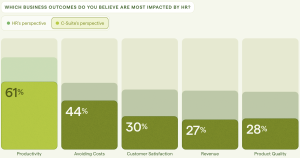
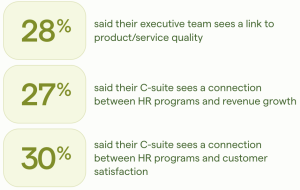
What’s the priority for 2024?
Last year HR activities that supported employee engagement topped CHROs’ list of top priorities for the third year running.
Suffering a significant drop in priority level are DEIB programs – falling by 50% compared to the importance it was afforded as recently as 2021.
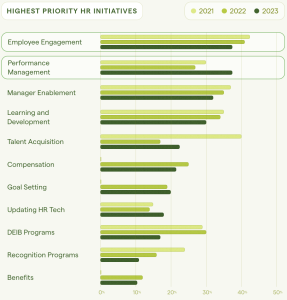
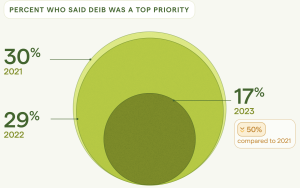
In fact, overall, diversity, equity, inclusion, and belonging (DEIB) programs have fallen from 30% in 2022 to 17% in 2023.
What this data really means, claims Lattice, is still a little unclear. “It’s possible that organizations may have completed the implementation of policies and are waiting for them to play out — or they may have backed off on efforts as DEIB has fallen from the spotlight. Either way, this may mean it’s time for HR teams to regroup on DEIB,” it says.
One thing is likely though.
There is also a suggestion DEIB is being de-prioritized in favor of other emerging areas deemed to be more important – such as AI – where some spend seems to be moving there (see next).
Where is HR budget being spent?
Tough times are indicated by trend seen in HR budgets.
HR budgets are only modestly increasing or staying flat.
Just 6% of HR teams say they will be significantly increasing their budgets this year, with more (42%) saying it will stay the same than ‘increase slightly’ (31%).
A significant one in five (20%), say their budgets will be decreasingly – either slightly (14%) or significantly (6%).
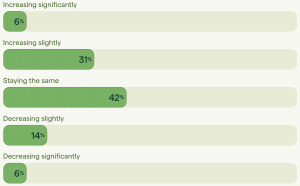
The effects of this can arguably be seen in terms of where HR money is being spent on or planned to be spent on.
Some have put spend into AI for example.
But while most HR teams (74%) say they’ve started having discussions about AI, and looking for ways to use AI in the business, just 38% are formally evaluating it or implementing AI solutions.
Only 15% of HR teams say they’ve already implemented AI, and nearly a quarter (24%) say they’ve not even thought about, or talked about AI – a sizeable proportion.
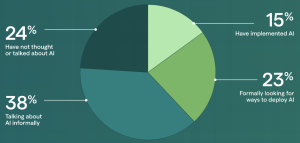
Could it be that technology isn’t proving itself?
There is a suggestion spend on HR technology is being hampered by it being able to perform to CHROs’ expectations (which then impacts CHROs’ own ability to prove their worth the business.
For the Lattice data suggests this is possibly the case.
It finds that more people say the top two most-popular software solutions are falling short of their expectations than exceeding its goals.
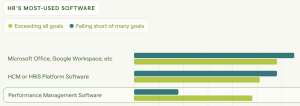
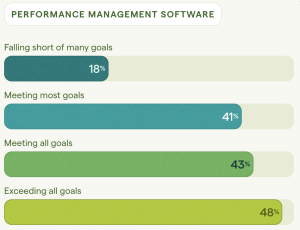
While performance management systems (forgive the pun), perform better, overall, nearly one in five (18%) still say it falls short of meeting its goals, while fewer than half (48%) say it exceeds all their goals.
But is having some technology better than none at all?
The answer is ‘yes’. Across the board, high-performing HR teams were found to invest differently in HR tech than low-performing teams do.
The highest-performing teams — those exceeding their goals — are 2.6 times more likely to be investing in performance management software than the lowest performers are.
In its survey, Lattice found 40% of all respondents indicate that they do use performance management software, but those who don’t use it report falling short of many of their goals.
CHROs need to demonstrate their value more
With only 11% of HR professionals saying they are exceeding their goals, and over half admit they fell short this year, it seems CHROs somehow need a confidence boost.
They could get it, suggests the research, by investing in tools that move their HR teams from low to high performance.
When CHROs create high performing HR teams, the data finds their confidence increases [in terms of demonstrating the link between HR and business objectives]; they feel supported by the C-suite, and because of all this, they then report greater confidence at being able to impact products/services, revenue growth, and cost avoidance.
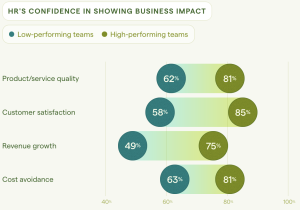
“Connecting with the C-suite is like a well-choreographed dance,” says Donald Knight, chief people officer, Greenhouse. “We need to find common ground, talk their language, but also infuse our unique HR insights. It‘s a tango of data, strategy, and heart.”
And it seems C-suite engagement is also critical to HR teams’ own sense of wellbeing.
The survey results show that HR teams that aren’t aligned with the C-suite are 59% more likely to feel burned out; 25% less likely to feel fully engaged with the job, and 50% more likely to worry about their own job security.
Q Hamirani, former global head of live and work anywhere, Airbnb, now chief people officer at Paper says: “People leaders often lead with people solutions first, business impacts second.”
He adds: “Taking the time to understand the business in depth — from what’s working well, to any headwinds the company is facing — will empower teams to lead with these big-picture challenges and align on the right people strategies from there, instead of the other way around.”
So how do you fare against all this?
If some of these metrics strike a chord, the good news is that you’re clearly not the only CHRO to feel like there is still a lot of work ahead in 2024.
But the research is also comforting in one important respect. Successful HRteams do actually have a lot in common.
Of those who feel they are exceeding their goals, 82% are confident in connecting their work to business outcomes, and 67% get sufficient support from the C-suite.
